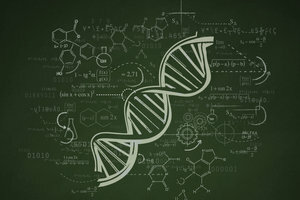From genetic information to protein
All the characteristics of an organism are stored in its genetic information. Every protein is synthesized according to this information, which is laid down in the DNA. But how exactly does it work?

The genetic information is in the DNA
- You probably know that all of your body's genetic information is contained in your genes. Genes are sections of DNA (deoxyribonucleic acid). Each gene defines a very specific trait, e.g. B. Her eye colour.
- The DNA is in the cell nuclei of your body. It consists of two interconnected strands, similar to a rope ladder. The rungs, the connection points, consist of two base pairs in every living being.
- The four bases are adenine (A), thymine (T), cytosine (C) and guanine (G). They are called base pairs because A only ever connects with T and C only ever connects with G. Whether you have blue or brown eyes is determined by the order of these bases.
A protein is synthesized
- When a protein needs to be regenerated in your body, the process of protein biosynthesis occurs. This means nothing else than that the sequence of the bases determines the structure of the protein.
- The genetic information that is in the DNA has to be translated. This process always takes place in the cell nucleus. The translation of the DNA never takes place on the original. First a messenger sequence, the m-RNA, is generated.
- For this purpose, the DNA double strand is untwisted and opened at the beginning of the gene that encodes the protein that is currently required. The connection of the base pairs is broken.
- The information is only ever read from one strand. To do this, the RNA migrates along the open base ends and tries out which base goes with it. If it finds adenine, it builds up uracil. RNA contains uracil instead of thymine. Only guanine fits cytosine. The m-RNA looks for the right “key” for each “lock”. This process is known as transcription.
- The m-RNA is channeled into the cell plasma via the pores in the nuclear membrane. Now the translation into amino acids takes place, the translation.
- On the m-RNA, the bases are always in packets of three, the so-called codons. Three bases in a row form a codon. A codon encodes an amino acid.
- The adapter that cracks this coding is the transfer or t-RNA. Every t-RNA has three bases on one side, the key. It wanders along the m-RNA until it has found the right lock, the right codon. There is an amino acid on the other side of the t-RNA.
- This process continues until each lock has found its key. The order of the bases in the DNA determines the sequence of the amino acids in the protein.
- This sequence in turn decides which protein is formed. Proteins have many in cells and in the body Functions. It is important that the right protein is always in the right place.
From gene to gene product
The genes determine the inheritable characteristics of an individual; but how exactly ...
How helpful do you find this article?

